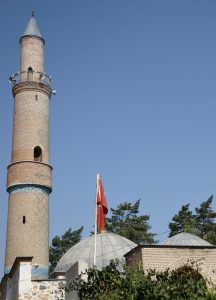Last resting place of Nasrettin Hoca Population: 62,000
Old name: Philomelium
This small town on the edge of the Turkish Lake District makes a good touring base as well as having enough of interest to justify a day’s visit. The association with medieval funny man Nasrettin Hoca becomes apparent even before you leave the bus station when you spot the statue of him on the roof. It means that Akşehir is more of a fun town than most in Central Turkey. A good place, then, to bring children who’re tiring of historic monuments.
Around town
The obvious starting point for a tour is the cemetery which houses the supposed tomb of Nasreddin Hoca with its cryptic reference (386, meaning 683) to the date of his birth. In front of it a plaque in the ground reads “Dunyanın ortası burasıdır (The Centre of the World is Here)” in memory of one of the Hoca’s statements.
Across the road Gülmece Parkı (Comedy Park) is filled with statues based on the Hoca’s stories as well as with reminders of Turkey’s other funny men, amongst them the gummy slapstick hero of more than 80 elderly Yeşilcam films, Kemal Sunal, who died prematurely in 2000 but whose films are still shown on television daily.
Akşehir has several museums, the most impressive being the archaeology museum housed in the Taş Medrese that dates back to 1250 (closed Mondays). The mosque attached to it has a curious minaret with something rather like a brick bracelet wrapped round its middle.
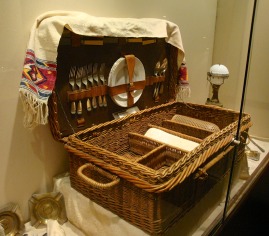 Atatürk’s picnic hamperThe small Akşehir Batı Cephesi Karagah Müzesi (Akşehir Western Front Headquarters Musem), is housed in the old belediye (municipality) building in the town centre close to the statue of Atatürk, and is of rather specialist interest since it celebrates the city’s role in the Turkish War of Independence (1919-22).
Atatürk’s picnic hamperThe small Akşehir Batı Cephesi Karagah Müzesi (Akşehir Western Front Headquarters Musem), is housed in the old belediye (municipality) building in the town centre close to the statue of Atatürk, and is of rather specialist interest since it celebrates the city’s role in the Turkish War of Independence (1919-22).
Interspersed with the many photographs there is a fairly predictable collection of Atatürk memorabilia, including an impressive picnic hamper and a magnificent set of bath accoutrements. These may have been used on a visit to the hamam (Turkish bath) right on the museum’s doorstep. A quick glance at the elaborate carvings around its doorway is enough to identify this as a work dating back to the Selçuk period although it’s still very much in use today.
A third very impressive archaeology and ethnography museum is housed in the lovely Rüstü Bey Konağı opposite the Ulu Cami. It contains a beautifully displayed collection of items running through Akşehir’s history since the earliest days. Highlights include a lovely hexagonal wooden box that would once have housed a Bible, and an intricately carved wooden sarcophagus taken from the tomb of Şeyh Eyyüb. Predictably one room is set up to show Nasrettin Hoca dining with friends. More unexpectedly another room commemorates the dying tradition of yarenlik whereby men would gather in each other’s homes in turn to talk and amuse themselves. Apparently only one such group is still keeping the tradition going locally (2011).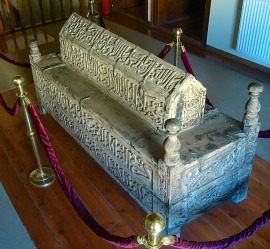
One other building open to the public is the lovely Akşehir Evi, a restored Ottoman house that plays host to a popular cafe while also enabling visitors to see what the interiors of 19th-century homes looked liked. Built in 1894 for an immigrant Macedonian timber merchant called Haci Yunus, it was bought and restored by an enthusiastic group of locals in 1991.
It’s well worth exploring the area around the Akşehir Evi where you’ll find slight traces of a medieval tower on the banks of a dry river, as well as the impressive early 20th-century belediye building.
Magnificent mansions, some of them with idiosyncratically asymmetrical cumbas (bay windows), rub shoulders with much simpler mud-roofed houses. If you keep walking you may also stumble upon the remains of an enormous 19th-century Armenian Orthodox church with a modern school housed in what would once have been the community school facing it.
But Akşehir also has a lot of other interesting religious buildings too. Facing the museum, the Ulu Cami is a masterpiece of Selçuk architecture dating back to 1213 and the reign of İzzettin Keykavus I. While heavy-handed restoration has rendered the interior mihrab more modern than convincingly Selçuk, there is, against the outside wall, a beautiful marble mihrab which retains traces of its original turquoise colouring as well as delicate graffiti in Osmanlı (Ottoman) script. As is typical of Selçuk mosques the roof is supported by a forest of columns, some of them sandwiched between bases and capitals that have obviously been scavenged from the ruins of Philomelium, the Graeco-Roman settlement that preceded Akşehir and of which there is now virtually no trace. The lovely brick minaret also retains some original turquoise tiling.
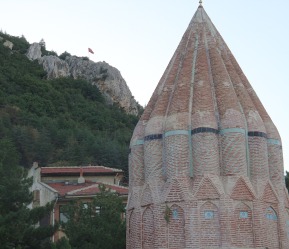 Also worth tracking down is the kümbet (tomb) of Seyit Mahmut Hayranı, a follower of Mevlana, who died in 1208. Surmounted by a fluted brick dome just like the one covering Mevlana’s tomb in Konya but without the glorious tiles, it was the work of an architect named Ahmed bin ‘Abd Allah bin Asli. Since he may also have been responsible for the version in Konya it’s suprising that this kümbet doesn’t attract more attention. Its walls incorporate many pieces of reused Roman masonry as do the walls of a second tomb that shares an enclosure with it.
Also worth tracking down is the kümbet (tomb) of Seyit Mahmut Hayranı, a follower of Mevlana, who died in 1208. Surmounted by a fluted brick dome just like the one covering Mevlana’s tomb in Konya but without the glorious tiles, it was the work of an architect named Ahmed bin ‘Abd Allah bin Asli. Since he may also have been responsible for the version in Konya it’s suprising that this kümbet doesn’t attract more attention. Its walls incorporate many pieces of reused Roman masonry as do the walls of a second tomb that shares an enclosure with it.
There’s even more ancient masonry to be seen in the walls of the Küçük Ayasofya Mescidi (1235) as well as in those of the pretty Güdük Minare Cami (Squat Minaret Mosque, 1226).
It was only with the coming of the Ottomans that the locals finally seem to have abandoned the practise of reusing old stones, as you’ll see if you visit the smooth-walled İmaret Cami (Soup Kitchen Mosque), built in 1510 for Hasan Paşa, a governor of the Ottoman Empire’s Balkan territories, and a rare example of an early Ottoman mosque in Central Anatolia.
Wandering around town you’ll find lots of lovely old houses, some of them now being given a new lease of life, especially in the area around the Ulu Cami.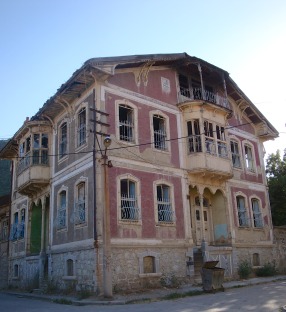
Finally you may want to look for the ruins of the vast 19th-century church that served the Greek community until 1924.
Sleeping
Grand Bal Hotel, Akşehir. Tel: 0332-811 0271
Önder Hotel, Akşehir. Tel: 0332-813 7277
Transport info
Regular buses link Akşehir with Konya, Afyon and Isparta.
Day trip destinations
